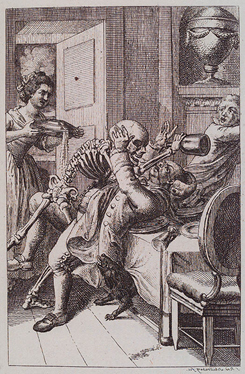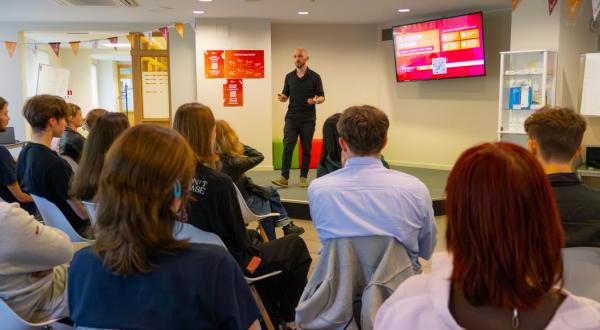Zinātniskās anatomijas pamatlicēja Vezālija jubilejai veltīta vieslekcija
RSU Medicīnas vēstures institūts ielūdz uz Hoffmann-La Roche vēsturiskās kolekcijas un arhīva kuratora no Šveices Aleksandra Bjeri (Alexander L. Bieri) vieslekciju angļu valodā Andreas Vesalius' lasting impact on the art of the Danse Macabre. Lekcijas notiks pirmdien, 20. aprīlī, pulksten 12.00 Rīgas Stradiņa universitātē 3. auditorijā un trešdien, 22. aprīlī, pulksten 8.15 Rīgas Stradiņa universitātes 2. auditorijā.
Lekcijas notiek zinātniskās anatomijas pamatlicēja Andreasa Vezālija (1514–1564) 500 gadu jubilejas pasākumu ietvaros.
 During the middle ages, the danse macabre developed into an independent art form, most often in the shape of murals which adorned the walls of cemeteries. These depictions of death followed a strict rulebook and generally were a representation of the class system of the time, which was based on nobility or – to be more precise – the estate-based society. The advent of the bourgeois during the 1700s and the upcoming industrialisation put a question mark not only behind the societal system, but quite naturally also behind many of the established art forms. The danse macabre was widely regarded to be an outdated concept and a discussion evolved whether the skeleton still was the appropriate epitome for death.
During the middle ages, the danse macabre developed into an independent art form, most often in the shape of murals which adorned the walls of cemeteries. These depictions of death followed a strict rulebook and generally were a representation of the class system of the time, which was based on nobility or – to be more precise – the estate-based society. The advent of the bourgeois during the 1700s and the upcoming industrialisation put a question mark not only behind the societal system, but quite naturally also behind many of the established art forms. The danse macabre was widely regarded to be an outdated concept and a discussion evolved whether the skeleton still was the appropriate epitome for death.
One of the proponents of this discussion was the Swiss artist Johann Rudolf Schellenberg, who created the first modern danse macabre in 1785, far away from the old class system, a work of art which still has an uncanny actuality and addresses many of the modern fears still extant in society at present. However, Schellenberg also followed closely the anatomical knowledge and it is quite clear that he used Andreas Vesal's "De Humani Corporis Fabrica" for inspiration, which was printed in Basel 200 years earlier. Even though Vesal's famous book did inspire other artworks early on, it was Schellenberg who directly referenced the style of the plates of the anatomical atlas. His trailblazing work updated the genre overnight and can be seen as the master source of all similar works of art to follow.
A complete set of the Schellenberg plates is held by the Roche Historical Collection and Archive in Basel, which also holds one of the world's oldest anatomical collections. The lecture not only discusses Schellenberg's danse macabre in detail, but also gives an insight into the current fascination with vanitas and its depictions, especially focusing on the artistic exploitation of the theme and takes into consideration the history of anatomical dissection and preparation.
 Alexander L. Bieri (b. 1976) is the curator of the Roche Historical Collection and Archive, a department within Roche Group Holdings. He assumes this position since 1999. Based in Basel, Switzerland but active as a consultant throughout the world, he has published many books and articles both on Roche-related and other themes. He also is responsible for a variety of Roche in-house museums and curated special exhibitions in Switzerland and abroad. In his capacity as an expert for 20th century architecture and design, he is a member of ICOMOS. In 2012, he was appointed lecturer for exhibition design at the Basel University. This lecture belongs to a series of lectures organized by M-Museum Leuven.
Alexander L. Bieri (b. 1976) is the curator of the Roche Historical Collection and Archive, a department within Roche Group Holdings. He assumes this position since 1999. Based in Basel, Switzerland but active as a consultant throughout the world, he has published many books and articles both on Roche-related and other themes. He also is responsible for a variety of Roche in-house museums and curated special exhibitions in Switzerland and abroad. In his capacity as an expert for 20th century architecture and design, he is a member of ICOMOS. In 2012, he was appointed lecturer for exhibition design at the Basel University. This lecture belongs to a series of lectures organized by M-Museum Leuven.
Saistītās ziņas
 Attīsti uzņēmējdarbības prasmes un pārvērt idejas reālos risinājumos B-Space inkubācijas programmā!Darbiniekiem, Skolēniem, Studentiem, Inovācijas
Attīsti uzņēmējdarbības prasmes un pārvērt idejas reālos risinājumos B-Space inkubācijas programmā!Darbiniekiem, Skolēniem, Studentiem, Inovācijas

